According to the American Society for the Prevention of Cruelty to Animals (ASPCA), dog aggression or aggressive dog behavior is THE most serious canine behavior problem.

It’s also the most common reason for dog owners to seek help from vets, trainers, and dog behaviorists.
In this article, we have put together everything that a dog owner must know about how to deal with dog aggression responsibly.
Should I Be Concerned About My Dog’s Aggression?
Yes! Aggressive dog behavior is a cause for concern for any dog owner. Not only can it result in injury to people or other dogs, but it can put their master at risk of an expensive lawsuit.
Biting is the most extreme aggressive behavior in dogs, but growling, snapping, and lunging are also indicators that your dog has a temperament problem.
Every year in the United States, 4.5 million people are bitten by dogs, according to DogsBite.org. In the year 2018 alone, 27,000 people underwent facial reconstruction because of dog attacks, and 36 victims died. Of those 36, 15 were children.
Those are some pretty sobering statistics. In this study, four breeds were found responsible for 90% of attacks on humans—the Pit Bull, Rottweiler, Bullmastiff, and Dogo Argentino.
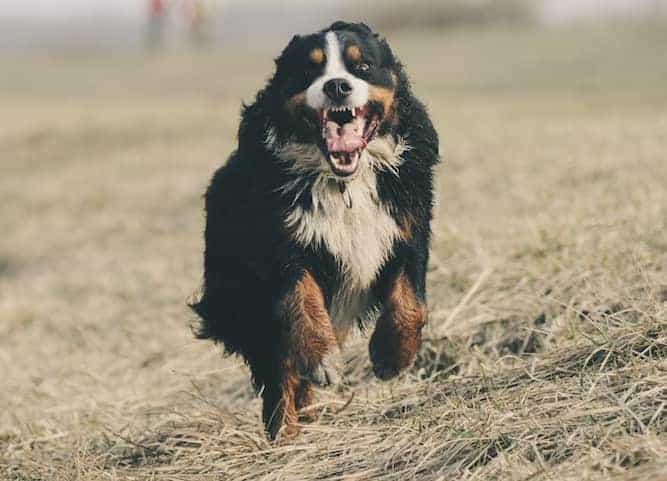
But in another study by DogsBite.org over 14 years, 433 human deaths were caused by 35 different breeds.
While statistics clearly show that some breeds are more likely than others to display aggressive dog behaviors, it’s clear from these numbers that any dog can attack a human being.
A look at the ASPCA’s web site reveals that there are many types of dog aggression, some more worrisome than others. But they all need to be dealt with before a dog seriously or even fatally injures someone.
No matter what type of aggression your dog is showing, or how minor it appears to you, dog aggression is always a reason for concern!
How Many Types of Dog Aggression Are There?
The ASPCA recognizes 11 different forms and causes of aggressive dog behavior, as follows:
Territorial Aggression
This can be limited to “intruders” coming into the house, or it can be the guarding of “his” territory outdoors.
Protective Aggression
Examples are protecting a family member from a real or imagined threat, or a mother protecting her puppies.
Possessive Aggression
This includes food aggression or guarding of other resources such as toys.
Fear Aggression
This is one of the most common reasons for dog aggression.
A fearful dog will usually cower or run, but a scared dog who is confined or feels cornered will often strike because he sees no escape route.
Defensive Aggression
A type of fear aggression, but in this case, the dog doesn’t cower; he simply attacks.
Social Aggression
This is sometimes called dominance aggression. Think of it as dog bullying.
It’s a common reason for dog-on-dog aggression in the home.
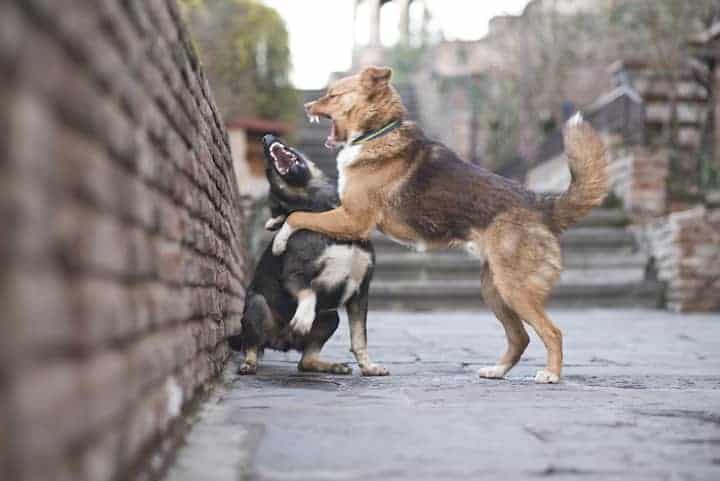
A dog may become aggressive to a family member or other dog over food or other resources because he feels they are lower than he is in the social hierarchy.
Frustration Aggression
A dog may be frustrated by barriers such as crates, leashes, and walls, or by being confined when he wants to get at or to something.
Redirected Aggression
A typical example of this is when a dog is making aggressive moves toward another dog and a human intervenes. The dog may turn his aggression toward the person. For this reason, never try to break up a dog fight.
Pain Aggression
Pain can make a dog snap or bite, even when a person is trying to tend to the source of his pain.
Sexual Aggression
Intact males can become aggressive toward other dogs when fighting for breeding rights. Unspayed females can also fight among themselves if there is an intact male around.
Predatory Aggression
This is the instinctive prey drive that many breeds have.
They usually direct it toward other animals, but it’s also the most common reason for dog aggression toward children (mostly infants).
This is one reason why many dog experts advise never to leave young children alone with a dog.
Dog-on-dog versus Dog-on-people Aggression
Another useful way to categorize causes of aggression is to look at them as aggression toward owners and family, aggression toward strangers, and aggression toward other dogs.

Some of the types of aggression listed above can be directed to any of these three targets. Some breeds will typically show aggression in one of these areas but not the others.
Of course, dog aggression toward humans—family members or strangers—is the most serious.
Aggressive dog behavior toward other dogs can also cause significant problems for a dog owner. But dog-on-dog aggression can sometimes be “trained out” of a dog by its owner.
If your dog has dog-on-person aggression, however, you will need to get professional help from a dog behaviorist. This is particularly true if your dog is a breed with a high genetic risk of aggression.
Is Dog Aggression Genetic?
To some degree, yes, aggressive dog behavior is hereditary. Certain breeds are more prone to aggressive behaviors than others.
A recent study of 14,000 dogs of 101 breeds sheds some light on this classic “nature or nurture” question.
The study found 14 behavioral dog traits with a genetic origin. Those 14 include genes for trainability, chasing (prey drive), attachment, attention-seeking behaviors, and aggression toward strangers.
Overall, the study found that 60% to 70% of a dog’s behavioral traits are inherited. This suggests that the prevention or management of some aggressive behaviors may be challenging.
But Can Dog Aggression be Prevented?
In many cases, yes, but not always. The key to preventing dog aggressive behavior is early socialization.
A dog that is well-socialized from puppyhood is far less likely to be fearful or anxious.
Teach them that it’s okay for someone to pick up their food bowl or to take their favorite squeaky toy. Make this a positive experience with treats and cuddles when they behave nicely.
This is particularly important for breeds that are more likely to have aggression issues.
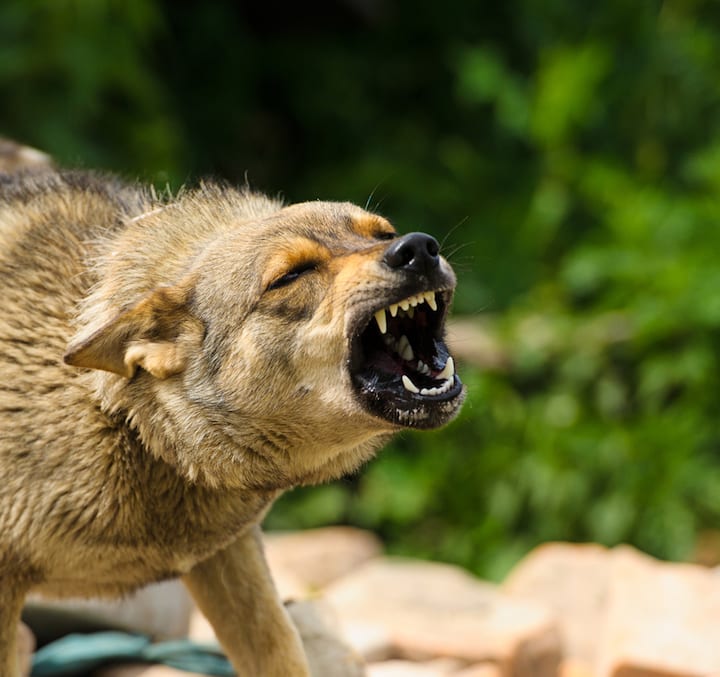
It’s also a good argument for purchasing a dog from a reputable breeder.
We don’t advocate purchasing over adopting (or vice versa). But in the case of a breed that has aggression in its genes, knowing what you’re getting is important.
If you have children in your home, it’s critical.
Of course, there’s no guarantee that any dog will or won’t tend towards aggression. But when you purchase from a good breeder, the odds are in your favor that a dog will be well socialized from birth.
You will also not have to worry about the environment and training that a potentially dangerous dog experienced before it found its way to a rescue or shelter.
This, unfortunately, is a very common cause for aggressive dog behavior with Pit Bull breeds.
Poor socialization or an abusive history can lead to a fearful or anxious dog. And fear and anxiety are the causes of most aggression issues in dogs.
Add a genetic predisposition to aggression, and you have a high-risk situation, especially if there are children in the home.
How Do I Prevent Dog Aggression to Children?
Even if you’re considering a family-friendly breed, remember that any dog can bite. Children need to be taught right away to treat dogs respectfully.

Here are some suggestions:
- Children under five should never be left alone with a dog.
- Never lay an infant down near a dog. Dogs sometimes mistake squirming or crying babies for prey. This is one of the most common causes of fatal dog attacks on children.
- Don’t feed the dog in a room with young children.
- All children should be taught not to hug a dog. Dogs generally don’t like to be hugged, as it makes them feel confined. They often show signs of anxiety when being hugged by anyone, child or adult. Hugging a dog is a common cause of facial bites to children.
- Children should not bother the dog when he’s eating or sleeping.
- They should never try to take a toy away from him.
- They should know to back off immediately if a dog growls at them, and to tell an adult.
- Know the warning signs that a dog is fearful or anxious and teach them to your children.
- Be sure your dog is adequately socialized in general and to children in particular.
How Do You Socialize an Aggressive Dog?
Even in a home with no children, socialization is important. In the case of an aggressive breed, it’s essential.
Socialization is pretty easy to do with a puppy merely by exposing it to a lot of different experiences.
If you’re dealing with an aggressive dog, though, your dog is most likely an adult who was not properly socialized as a pup. This situation takes special consideration.
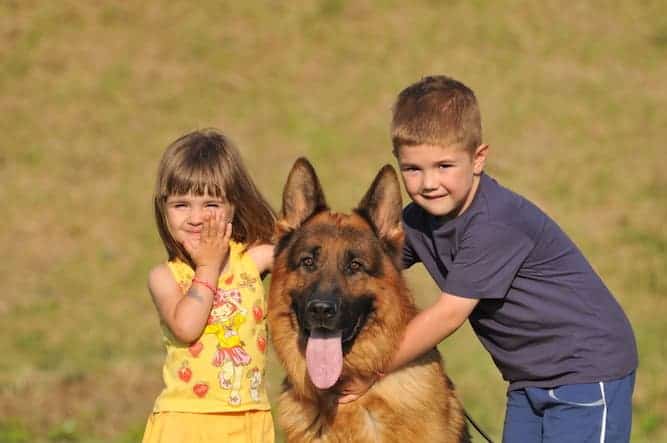
The following is a regimen that works for some aggressive dogs.
- Use a muzzle whenever you take your dog out.
- Start with lots of walks in quiet places with only a few people and dogs and not a lot of cars or noise. Don’t pull on his leash if he looks as though he might lunge. Instead, give treats to distract him immediately if he shows signs of fear or anxiety.
- When your dog is handling that well, gradually work your way up to busier environments.
- The next step is to try a dog park. The first time or two, just walk around the perimeter of the park. Let him interact with other dogs through the fence if he likes, and reward him for any interactions that go well.
- When he’s ready, try bringing him inside the park on the next visit.
- At home, have him meet new people one at a time. Have friends or family members greet him calmly and offer a treat. Reward him well if he shows no signs of fearfulness or aggression.
- Above all, be patient. The socialization process can take longer with adult dogs than with puppies, especially with a fearful dog.
Are There Warning Signs of Dog Aggression?
Until the socialization process has brought about a reliable change in your dog’s behavior, you will need to learn dog aggression signs and to be hypervigilant about watching for them.
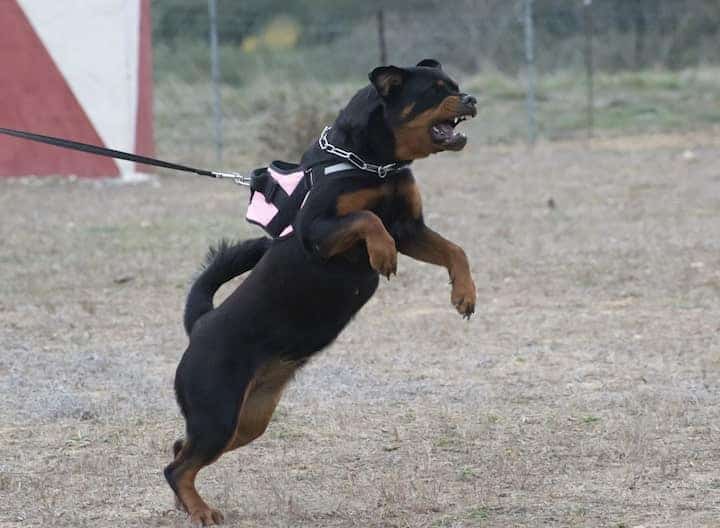
The following are the most common warning signs that a dog might attack, according to the American Kennel Club (AKC). You should familiarize everyone in the household with this list.
- A dog will often give a warning growl before striking.
- He may refuse to make eye contact and turn his head away.
- You may see the whites of his eyes. They’ll often look like a crescent moon on just one side of the eye.
- You may see the hair on his back stand up.
- He may yawn or lick his lips. These are usually signs that a dog is anxious and wants to be left alone.
- His ears may be flattened, or they might stand straight up.
- His entire body may stiffen.
- He may wag his tail, but it will look different than a happy wag. For example:
- His tail will stand straight up and move rapidly from side to side.
- His entire body may be rigid.
- And his rear end will not be wagging along as a happy dog’s does.
- He may tuck his tail between his legs and cower away. These are signs that a dog is scared, and a frightened dog is more likely to bite.
How Do You Treat Dog Aggression?
Some types of dog aggression are “trainable,” or manageable. It depends on the kind of aggression you’re dealing with. The following are specific aggression training tips for treating dog aggression.
Dog-on-dog Aggression
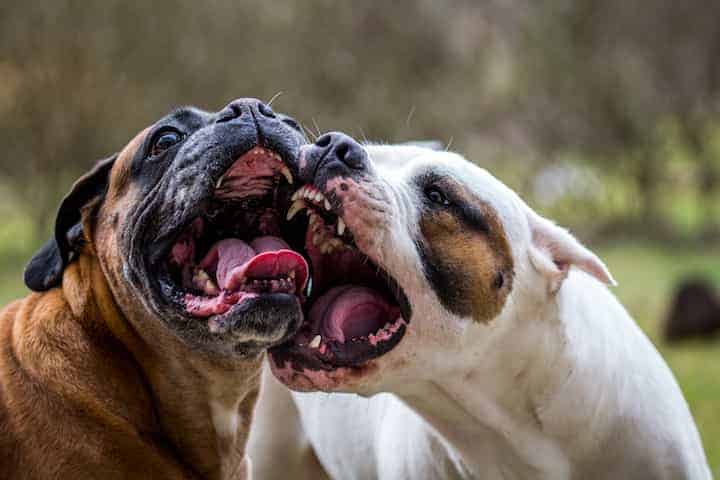
Territorial Aggression
There are several ways to stop territorial aggression in dogs. One that experts often use for dog aggression toward other animals is called the “jolly routine.” It may sound silly, but it often works.
Immediately when your dog sees a stimulus (for example, a dog walking by the window), start “jolly talking” him. Use a happy voice, laugh, and generally have fun with him.
At the same time, feed your dog treat after treat until the other dog is no longer in sight. Then immediately stop the jolly talk and the treats.
Do this every time this happens, and your dog will soon be ignoring the dog outside. He will only be interested in the treats and your attention. You can then gradually phase out the treats.
This method can also work for walks on leash and other similar situations.
Sexual Aggression
The simplest solution is spaying or neutering. This is known to calm aggression related to sex and breeding in both males and females.
Pain Aggression
Anytime a dog becomes suddenly aggressive when he was not before, you should get a vet checkup.
Your dog could be suffering pain from an illness or injury.
Predatory Aggression
In dogs with instinctive prey drives, this is much harder to control. We now know that chase is one of the 14 traits found to be genetic in dogs.
This means that the only way to be 100% sure that a dog will not see a baby as prey is to never leave a dog alone with a small child.
You may be able to train your dog to be OK with small pets in your home, but again, it’s impossible to be 100% certain he will never chase your cat.
And you may never be able to control his seeing a friend or family member’s small dog as prey. Once again, the only way to be certain is avoidance of these situations.
Social Aggression
A good behavior modification program can control this type of aggression, according to Dr. Sophia Yin of CattleDog Publishing. She uses a method called “Learn to Earn,” which teaches the dominant dog that he has to earn all rights and privileges.
By rights and privileges, she means pretty much everything. The dog learns to do an automatic sit before he is fed, goes outside, gets a toy—anything at all that he wants from you.
The goal is for your dog to learn that you are the source of all good things. This method basically “puts the dog in his place” and teaches him that he is not in charge of resources—you are.
See How to Handle Dog Aggression Toward Other Dogs and How to Stop Dog Food Aggression for more information about dog-on-dog aggression.
Dog-on-person Aggression
If your dog is showing dominance aggression to humans in the home, you have a dog-on-person aggression situation. This category would also include fear aggression and defensive aggression.
You should not try to handle this or any other type of dog aggression toward people on your own.
At the very least, you should consult a dog behavioralist for help. They can help you determine if your dog’s issues are manageable.
If there are children in the home, however, or your dog is a breed that is genetically prone to aggression, the situation is a tragedy in waiting. You may have to consider rehoming the dog.
What Do You Do with an Aggressive Dog that Bites?
If your dog bites someone, the first thing to do is to see to the victim. Then you need to notify the local authorities.

You will need to show proof of rabies vaccination, and your dog may be quarantined.
Depending on the state you live in, you could also be held legally and financially responsible for any damage your dog does to a person.
See Stop Dog Biting (and How to Prevent It) for a full discussion on dog biting/attacks and owners’ legal responsibilities.
Where to Find Help
If you decide that you would rather leave aggression training to a professional, then depending on where you live, you have several options.
Certified dog trainers and dog behaviorists are different types of professionals.
A trainer is qualified to deal with many mild behavior issues. A behaviorist has more education than a trainer and specializes in behavior problems.
If your dog has only mild to moderate aggressive tendencies, a trainer may be all that you need.
The Certification Council for Professional Dog Trainers is the trade group that certifies trainers. They maintain a searchable database of certified dog trainers on their website.
The International Association of Canine Professionals is another organization that certifies dog trainers. Their database is searchable by zip code.
But if your dog has moderate to severe aggression issues, you would probably want a dog behaviorist. Compared to dog trainers, they have more education in dealing with behavior problems.
The Animal Behavior Society is a professional organization that certifies dog behaviorists they also maintain a directory on their website.
Some of these behaviorists offer phone consultations. This would be a good option if you’re considering trying the training regimen yourself but would feel more comfortable touching base with a professional from time to time throughout the process.
Conclusion
Of all of the challenges of dog ownership, an aggressive dog is the most serious. Prevention is possible when dogs are properly socialized as puppies.
But when a dog owner finds themselves with a poorly socialized dog with aggression issues, there are ethical, legal, and financial risks to not dealing with the problem.
In some cases, aggressive dogs can be “reprogrammed” with good socialization and behavior modification techniques.
But in other situations, especially with dog-on-person aggression or an aggressive dog in a home with young children, dog owners have to make difficult choices.
If the owner of a potentially dangerous dog is unable or unwilling to commit to a behavior modification program, the only responsible solution is to rehome the dog.
In severe cases of dog aggression where a dog has severely bitten or attacked a person, the dog may need to be euthanized.
Resources and Further Reading
- American Society for the Prevention of Cruelty to Animals (ASPCA). “Aggression.”
- Centers for Disease Control and Prevention. “Preventing dog bites.” April 8, 2019.
- Coren, Stanley, PhD. Psychology Today. “The data says ‘don’t hug the dog!’” April 13, 2016.
- Cotroneo, Christian. Mother Nature Network. “Why are some dogs more aggressive than others?”
- Kane, Gary. American Kennel Club (AKC). “Watch for warning signs of an aggressive dog.” May 12, 2015.
- MacLean, Evan L. et al. Proceedings of the Royal Society B. “Highly heritable and functionally relevant breed differences in dog behavior.” October 2, 2019.
- Miller, Pat, CBCC-KA, CPDT-KA. Whole Dog Journal. “What causes aggressive dog behavior?” Updated May 8, 2019.
- Yin, Sophia, DVM. CattleDog Publishing. “The learn to earn program: developing leadership in humans and impulse control in dogs.”

Calvin is the co-founder and one of the main contributors to dogtemperament.com. He has been an avid dog lover all his life. He enjoys researching and sharing great ideas on how you can avoid common pitfalls of dog ownership and build the most loving and enjoyable relationship with your dog.